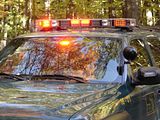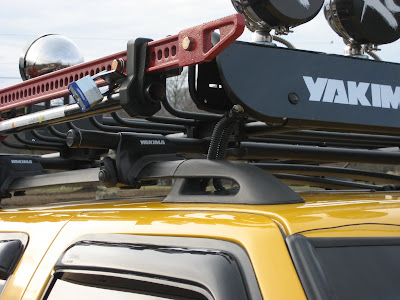Here is my thought, and it may be all wet (and probably is).
I always like the direct battery connection for all lights, on both positive and negative, to achieve the highest output from the lights. I also like the largest wire possible/reasonable, for the same reasons.
What I
think I would do is this.
First off the rack would be fed power and ground (with a fuse at the battery) directly from the battery. Both wires would have a connector of my choice placed in the proper location, maybe something like the warn winch connector but smaller and waterproof.
The ground would be run to the rack directly, to essentially direct battery ground the rack.
The positive cable would be run into a waterproof box on the rack itself where it would hit a terminal block that splits it to the relays. The small guage trigger wires would then run back through a separate connector and into the cab.
The lights could then be grounded using self tapping screws and ring terminals to the rack itself, and the power wires could then be run to the relays using wire that is not longer than what is required to get from the light to the relays. If I went really nuts each light would have a wire running a sealed mini fuse, or maybe just between the terminal block and the relays.
It looks like there is enough room under the rack to mount a small box so that is where I would probably put the relays and the terminal block. Access on the trail might be a little limited in that location though, on the other hand, having the opening for the box facing down would prevent water from getting to the relays or terminal block.
This is just me thinking, probably not the best setup and probably very expensive and complicated, but hey what the hell, it's late and I felt like typing. About the biggest problem I see with this is you would have a "hot" wire running outside the truck at all times, even with the connector unplugged. You would have to make sure that no water could get to the relay box, or into the connector when the rack was off. Or you could just put a switch on the power feed to the rack on the battery. I guess the biggest thing here was trying to get all, or at least most, associated pieces on the rack itself, other than a few bits of wire and some switches everything else related to the lights is removed when the rack is removed. This would give you a power feed to the rack itself though in case there might ever be anything else needing power up there, would make installing those under rack neons easy

.
On another note:
In your case I would use relay connectors instead of just blade terminal for each wire/terminal on the relay (not sure which way you were planning on going with that). I would probably also run four relays next to each other, that way if a relay goes bad you can just unplug one connector on the relay and transfer it to the fourth spare relay in a matter of seconds, and not run the possibly of getting the wires switched around.
When you do run this setup, don't forget to keep whatever connector you have covered in di-electric grease at all times.
[size=75][b]1991 GMC Sonoma Extended Cb[/b] - 4.3L Automatic, 2" BL, 31" BFG's.
[b]1992 Chevy T-10 Reg Cab[/b] - 4.3L 5spd, 3" Bl, 31" Mud Tires. Hooker long tube headers and true duals.
[b]1999 Oldsmobile Bravada[/b] - Wifes truck, all stock.[/size]























